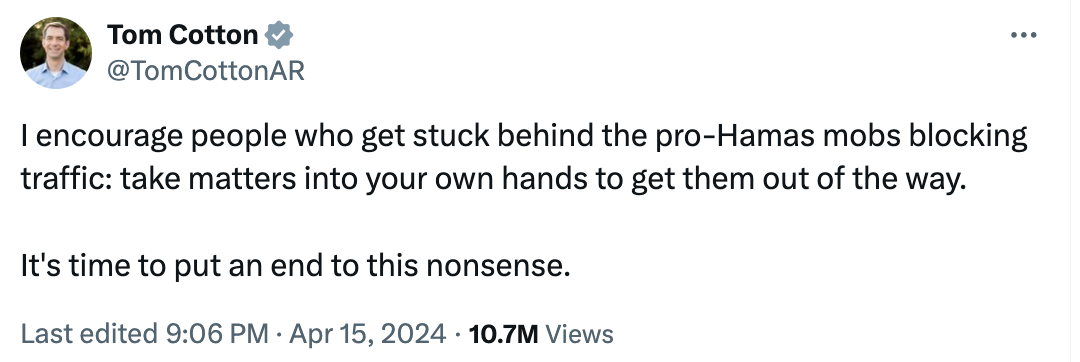The Legitimation of Violence Should Scare Us All
Violence has and always will be a central part of any successful fascist movement, largely because intimidation is necessary when such a small portion of the population supports your hideous policy goals, as much as those exist in a fascist movement.

This is the third in a series analyzing The Anatomy of Fascism. Click here to read Part One. Click here for Part Two.
You expect the rabble rousers and ruffians and hooligans and others known by old timey colloquialisms to threaten violence.
In fascist movements both modern and long past, it’s these rank-and-file folks who identify as the muscle of the movement, the people who can bend the will of a populace with sufficient threats and the occasional following through on those threats. The movement’s muscle has been a key – if abhorrent – selling point for industrialists and farmers who have joined forces with fascists over the generations to effectively crush labor rights by intimidating (and/or killing) workers agitating for better pay and working conditions. It’s how Mussolini obtained his first taste of power in Italy: Appealing to farmers who agreed to support his fascist party if his men would harass and intimidate farm workers who had become a key constituency of the nation’s socialist parties. We'll beat the shit out of workers cutting into your bottom line, Mussolini's men said, as long as you support us in the next election. The farmers' answer? Fine.
Bad Faith Times has a new $3 subscription level for those who want to support the publication headed into the 2024 election cycle. Thanks to all who support BFT!
That same muscle exists in today’s American fascist movement. Think of Donald Trump during a televised presidential debate telling the fascist Proud Boys to “stand back and stand by.” Think of the Trump-backing thugs who beat up peaceful, Bernie Sanders-aligned protesters at Trump rallies in the runup to the 2016 election. Think of the far-right paramilitary groups that organized the January 6 insurrection.
Violence has and always will be a central part of any successful fascist movement, largely because intimidation is necessary when such a small portion of the population supports your hideous policy goals, as much as those exist in a fascist movement.
So we’ve come to expect that any far-right political group worth its salt is going to deploy violence, or at least the threat of violence, to get its way. It’s a ugly reality, to be sure, but a reality nonetheless. It’s quite a different scenario when elected representatives are the ones issuing and making the threats, however.
Senator Tom Cotton of Arkansas, best known for writing a 2020 New York Times column in which he advocated for the president to crush racial justice protests with military might, last week urged motorists in San Francisco to “take matters into their own hands” and remove those protesting the violence against people in Gaza.

Perhaps most troubling, Cotton – unlike the Republican of yesteryear – did not walk back his X post when offered a chance to clarify what we really meant by “moving” protesters out of the way so traffic could be let through. Cotton seems to be blessed with the preternatural ability to speak in the vaguest terms possible, like a mob boss, like Donald Trump himself. Cotton – a sitting U.S. senator – didn’t explicitly tell folks to use violence against left-wing protesters. How motorists would “move” these protesters without violence is anyone’s guess, though I do have my theories, and all of them are nightmares.
Cotton then joined insurrection-supporting Senator Josh Hawley in writing an open letter to President Biden asking him to use that old National Guard trick to end protests in New York City. Cotton’s honesty about how to treat opposing political speech is quite refreshing and terribly instructive. It reinforced my long held belief that the American right cares not one iota about actual free speech, and that the free speech warriors’ never-ending song and dance about a censorious left is nothing more than projection. They hate free speech. It’s why they never shut up about it. Consider the word Cotton used to describe those who were protesting in San Francisco last week: Criminals.
Cotton and Hawley are not political insurgents banging down the proverbial doors of the American conservative movement. They’re not outside the Republican Party begging for attention and legitimacy, for any shred of political power. These men are part of the establishment of one of our two major political parties. Far from being outside the halls of power, Cotton and Hawley are entrenched in the Republican establishment. After reading Robert O. Paxton’s Anatomy of Fascism, I find this is pants-pissingly frightening for many reasons.
Fascist violence, as Paxton spells out in detail, has never been random or indiscriminate. It carries a “well-calculated set of coded messages” today, just as it did when Mussolini and Hitler – leaders of the only two successful fascist movements in history – rose to power in Italy and Germany, respectively.
…[leftist] violence was rising, the democratic state was responding to it ineptly, and only the fascists were tough enough to save the nation from the anti-national terrorists. An essential step in the fascist march to acceptance and power was to persuade law and order conservatives and members of the middle class to tolerate fascist violence as a harsh necessity in the face of leftist provocation.
Twentieth century fascists often found middle class willingness to wage violence against socialists and communists because those middle class citizens “never feared fascist violence against themselves.” They were reassured that such extreme measures would always be reserved to battle against “national enemies” and “terrorists” who deserved it. That violence, once legitimized by the voting populace and the conservative establishment, would never be allowed to run roughshod over anyone outside various socialist organizations. Or so they thought.
Dehumanization of leftists was (and is) an essential part of any fascist movement if it is to gain public trust and buy-in from politicians and entrenched interests. Cotton calling the San Francisco protesters “criminals” and Trump demeaning immigrants and his political opponents as subhuman might turn your spine to ice after flipping through Paxton’s analysis of what constitutes fascism.
A well-known Nazi Party theorist named Alfred Rosenberg, according to Paxton, time and again underscored the differences between “bourgeois justice” and justice according to his wretched and anti-human movement and party. So-called bourgeois justice says “one Polish communist has the same weighting as one German soldier,” whereas Nazi theory held that “one soul does not equal another soul, one person not another.” Rosenberg was charged with created a "human racial ladder" that would serve as the underpinnings for Nazi Party political theory. Rosenberg's hierarchy of humanity is a position that stands firmly in line with 21st Century fascist obsession with hierarchies of power (and oppression) and maintaining them by any means necessary.
This belief that “one soul does not equal another soul” is seen clearly in right-wing calls for end birthright citizenship, an issue that has been settled law for 125 years. People coming from Central America and South America should not be able to have a baby on U.S. soil and have that child hold American citizenship and all that entails, according to opponents of birthright citizenship, led by white supremacist Stephen Miller. Because, you see, one soul does not equal another soul. These same people are calling for immigrant camps and mass deportations. They're very upfront about these goals. For that, I suppose, we can be grateful.
The American right’s demonization and dehumanization of the country’s left fits nicely into a narrative that the glorious fatherland has been infested by enemies, not from without, but from within. Folks protesting war and racism and the repealing of bodily autonomy – these are internal enemies for someone like Tom Cotton, a man who cannot tolerate any amount of dissent.
“The legitimation of violence against a demonized internal enemy brings us close to the heart of fascism,” Paxton writes.
Fascists have long “indulged in the aesthetics of violence” against internal enemies, an aesthetic that has for generations proven irresistible to young men who have neither the patience nor the desire to achieve their aims through traditional politics. Finding beauty and honor in the deliverance of violent justice, they would much rather achieve various aims with a fist or a gun, or both. Mussolini, for his part, recruited heavily among World War I veterans who knew nothing but violence and wanted desperately to bring that terror to their homeland as a way of purging their cultural and political opposition.
When they hear an official’s clarion call to deliver such violence against those they hate – immigrants, women, people of color, socialists – they do not hesitate to join the fight. It’s all they’ve ever wanted. A sitting United States senator winking and nodding at these types to “take matters into their own hands” against peaceful protesters is horrifying; there is a large contingency that will listen and act with glee. It also means that the fascists are no longer demanding a seat at the table. They are already in power, waiting for a reason to visit upon their enemies the kind of legitimized violence we have not seen in the US.
Follow Denny Carter on BlueSky at @cdcarter13.bsky.social and on Threads and X at @CDCarter13.



Comments ()